LEXUS LX570 2016 Owners Manual
Manufacturer: LEXUS, Model Year: 2016, Model line: LX570, Model: LEXUS LX570 2016Pages: 632, PDF Size: 10.34 MB
Page 371 of 632
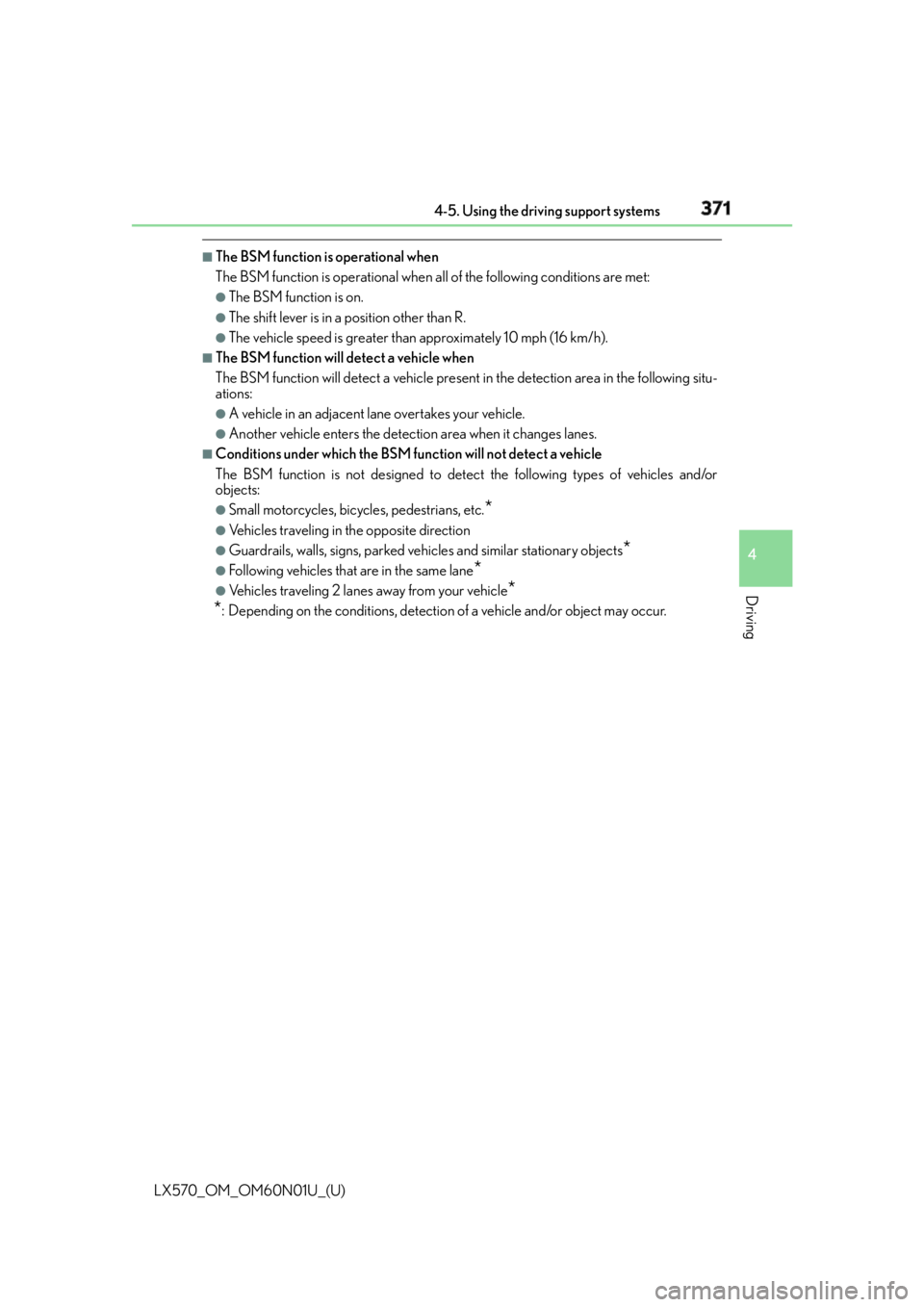
LX570_OM_OM60N01U_(U) 3714-5. Using the driving support systems
4
Driving ■
The BSM function is operational when
The BSM function is operational when all of the following conditions are met: ●
The BSM function is on. ●
The shift lever is in a position other than R. ●
The vehicle speed is greater than approximately 10 mph (16 km/h). ■
The BSM function will detect a vehicle when
The BSM function will detect a vehicle present in the detection area in the following situ-
ations: ●
A vehicle in an adjacent lane overtakes your vehicle. ●
Another vehicle enters the detection area when it changes lanes. ■
Conditions under which the BSM function will not detect a vehicle
The BSM function is not designed to detect the following types of vehicles and/or
objects: ●
Small motorcycles, bicycles, pedestrians, etc.
*●
Vehicles traveling in the opposite direction ●
Guardrails, walls, signs, parked vehi cles and similar stationary objects
*●
Following vehicles that are in the same lane
*●
Vehicles traveling 2 lanes away from your vehicle
*
* : Depending on the conditions, detection of a vehicle and/or object may occur.
Page 372 of 632
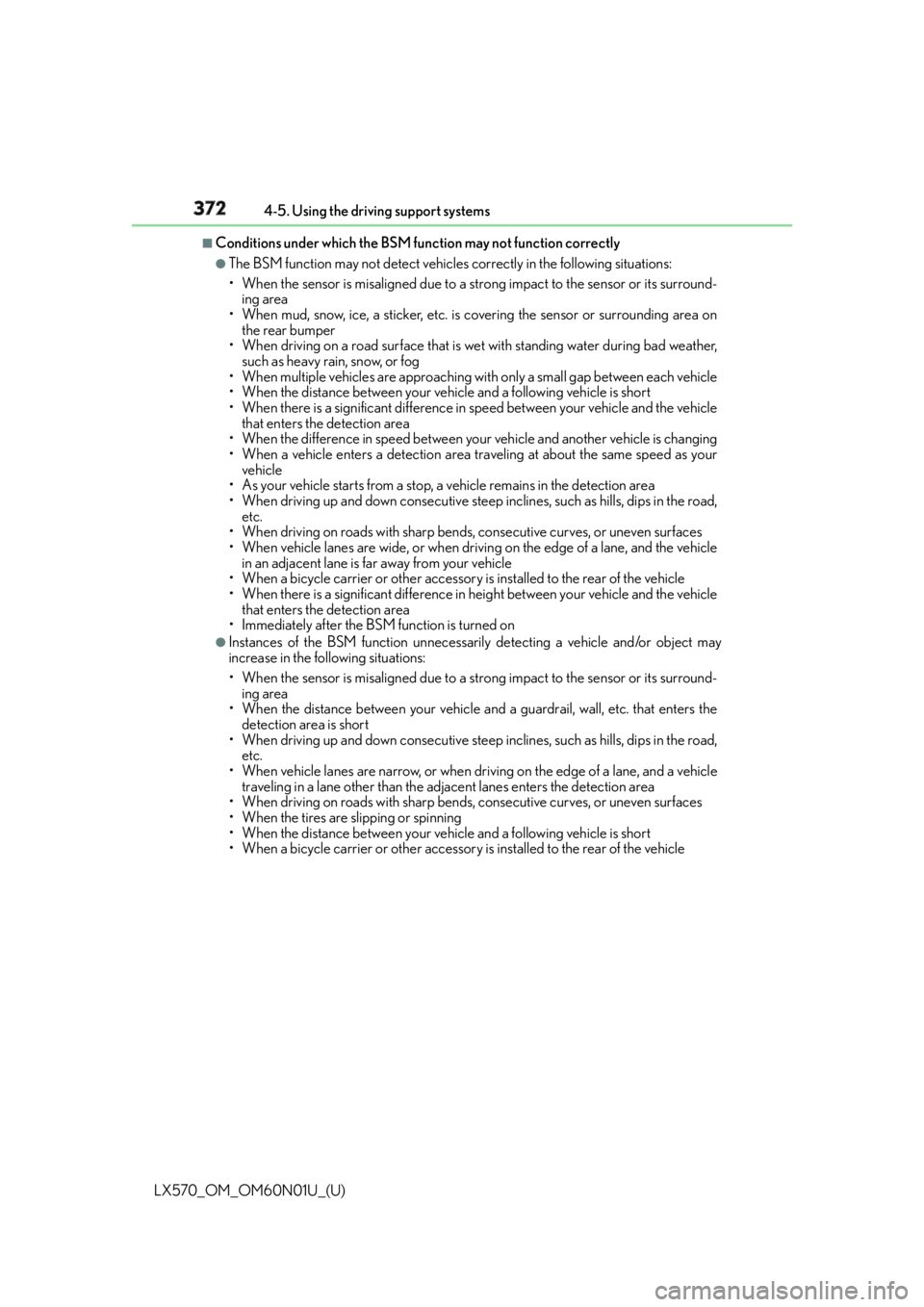
372
LX570_OM_OM60N01U_(U) 4-5. Using the driving support systems■
Conditions under which the BSM func tion may not function correctly●
The BSM function may not detect vehicles correctly in the following situations:
• When the sensor is misaligned due to a strong impact to the sensor or its surround-
ing area
• When mud, snow, ice, a sticker, etc. is covering the sensor or surrounding area on
the rear bumper
• When driving on a road surface that is wet with standing water during bad weather,
such as heavy rain, snow, or fog
• When multiple vehicles are approaching wi th only a small gap between each vehicle
• When the distance between your vehicle and a following vehicle is short
• When there is a significant difference in speed between your vehicle and the vehicle
that enters the detection area
• When the difference in speed between your vehicle and another vehicle is changing
• When a vehicle enters a detection area traveling at about the same speed as your
vehicle
• As your vehicle starts from a stop, a vehicle remains in the detection area
• When driving up and down consecutive steep in clines, such as hills, dips in the road,
etc.
• When driving on roads with sharp bends, consecutive curves, or uneven surfaces
• When vehicle lanes are wide, or when drivin g on the edge of a lane, and the vehicle
in an adjacent lane is far away from your vehicle
• When a bicycle carrier or other accessory is installed to the rear of the vehicle
• When there is a significant difference in height between your vehicle and the vehicle
that enters the detection area
• Immediately after the BSM function is turned on ●
Instances of the BSM function unnecessarily detecting a vehicle and/or object may
increase in the following situations:
• When the sensor is misaligned due to a strong impact to the sensor or its surround-
ing area
• When the distance between your vehicle and a guardrail, wall, etc. that enters the
detection area is short
• When driving up and down consecutive steep in clines, such as hills, dips in the road,
etc.
• When vehicle lanes are narrow, or when driving on the edge of a lane, and a vehicle
traveling in a lane other than the ad jacent lanes enters the detection area
• When driving on roads with sharp bends, consecutive curves, or uneven surfaces
• When the tires are slipping or spinning
• When the distance between your vehicle and a following vehicle is short
• When a bicycle carrier or other accessory is installed to the rear of the vehicle
Page 373 of 632
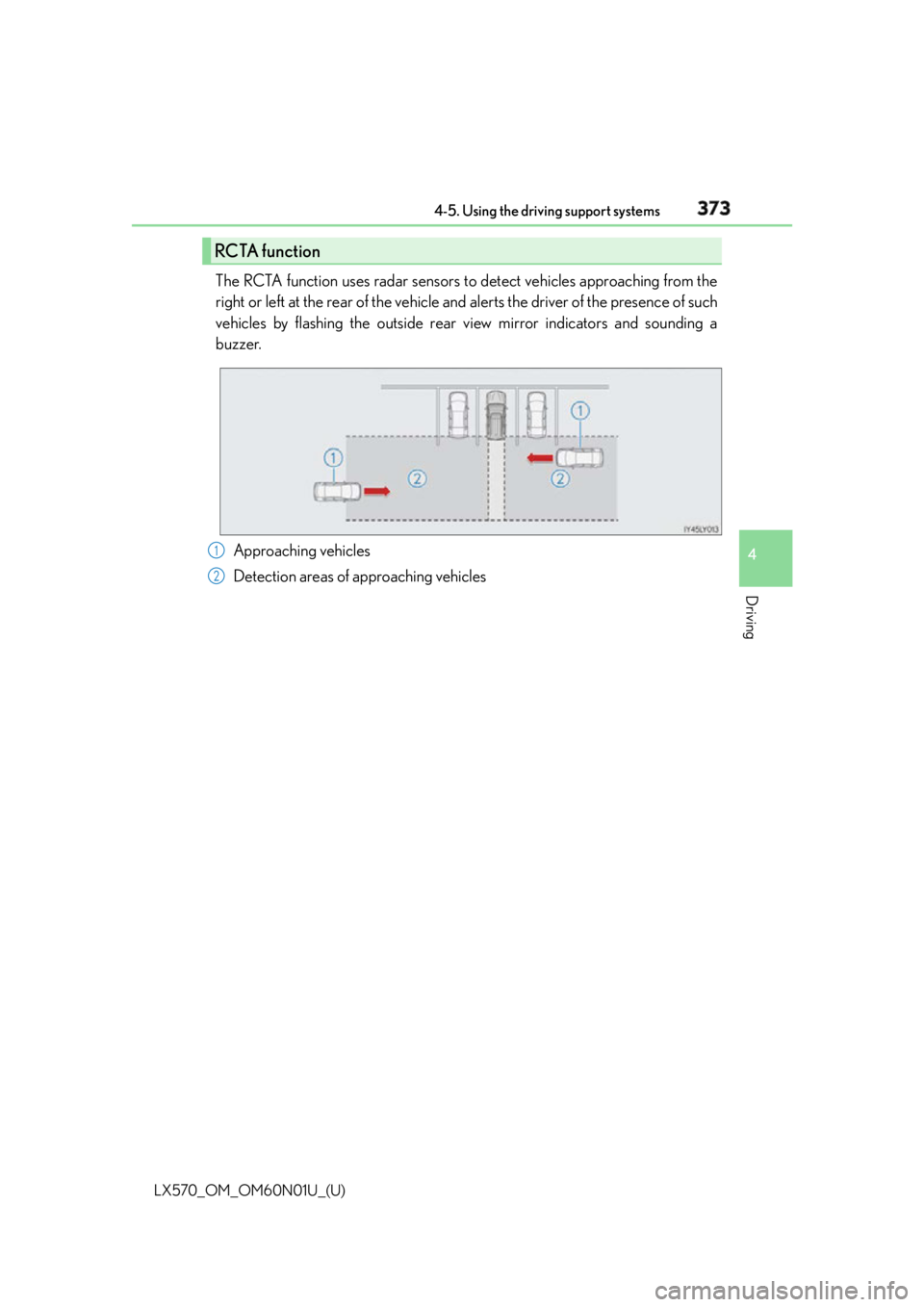
LX570_OM_OM60N01U_(U) 3734-5. Using the driving support systems
4
Driving The RCTA function uses radar sensors to detect vehicles approaching from the
right or left at the rear of the vehicle an d alerts the driver of the presence of such
vehicles by flashing the outside rear view mirror indicators and sounding a
buzzer.
Approaching vehicles
Detection areas of approaching vehiclesRCTA function
1
2
Page 374 of 632
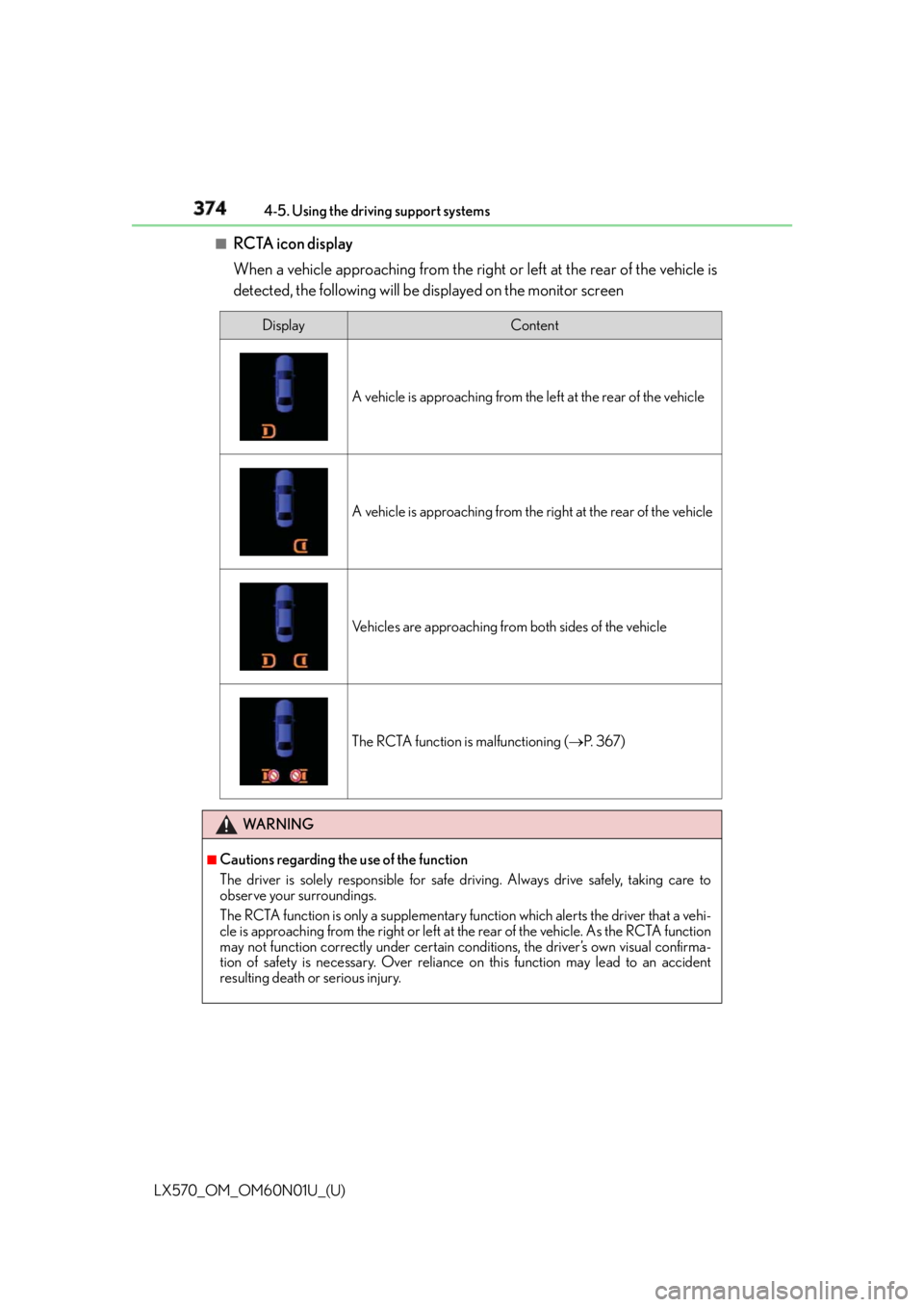
374
LX570_OM_OM60N01U_(U) 4-5. Using the driving support systems■
RCTA icon display
When a vehicle approaching from the right or left at the rear of the vehicle is
detected, the following will be displayed on the monitor screen Display Content
A vehicle is approaching from the left at the rear of the vehicle
A vehicle is approaching from the right at the rear of the vehicle
Vehicles are approaching from both sides of the vehicle
The RCTA function is malfunctioning ( P. 3 6 7 )
WA R N I N G ■
Cautions regarding the use of the function
The driver is solely responsible for safe driving. Always drive safely, taking care to
observe your surroundings.
The RCTA function is only a supplementary fu nction which alerts the driver that a vehi-
cle is approaching from the right or left at the rear of the vehicle. As the RCTA function
may not function correctly under certain conditions, the driver’s own visual confirma-
tion of safety is necessary. Over reliance on this function may lead to an accident
resulting death or serious injury.
Page 375 of 632
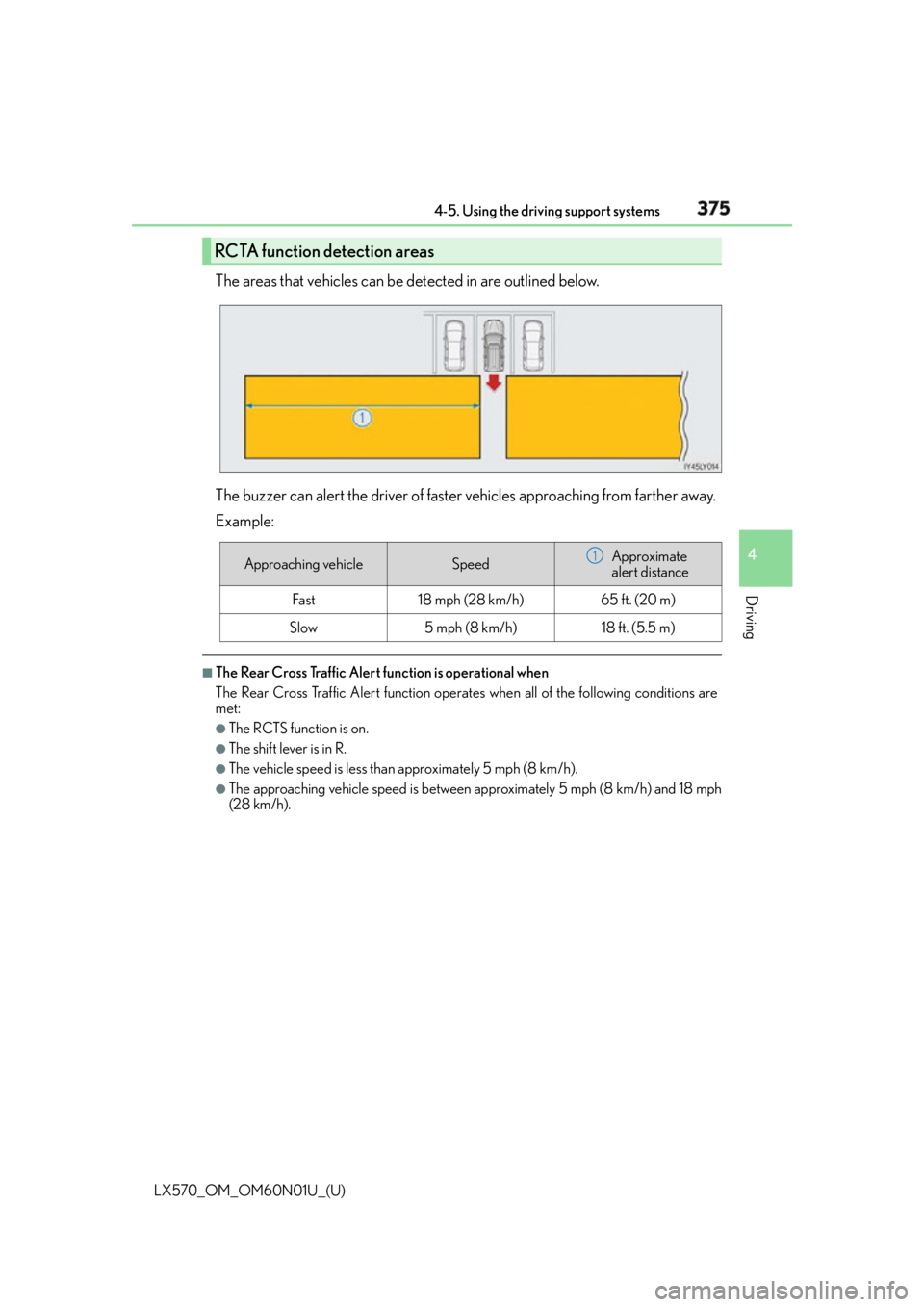
LX570_OM_OM60N01U_(U) 3754-5. Using the driving support systems
4
Driving The areas that vehicles can be detected in are outlined below.
The buzzer can alert the driver of faster vehicles approaching from farther away.
Example: ■
The Rear Cross Traffic Alert function is operational when
The Rear Cross Traffic Alert function operates when all of the following conditions are
met: ●
The RCTS function is on. ●
The shift lever is in R. ●
The vehicle speed is less than approximately 5 mph (8 km/h). ●
The approaching vehicle speed is between approximately 5 mph (8 km/h) and 18 mph
(28 km/h).RCTA function detection areas
Approaching vehicle Speed Approximate
alert distance
Fast 18 mph (28 km/h) 65 ft. (20 m)
Slow 5 mph (8 km/h) 18 ft. (5.5 m) 1
Page 376 of 632
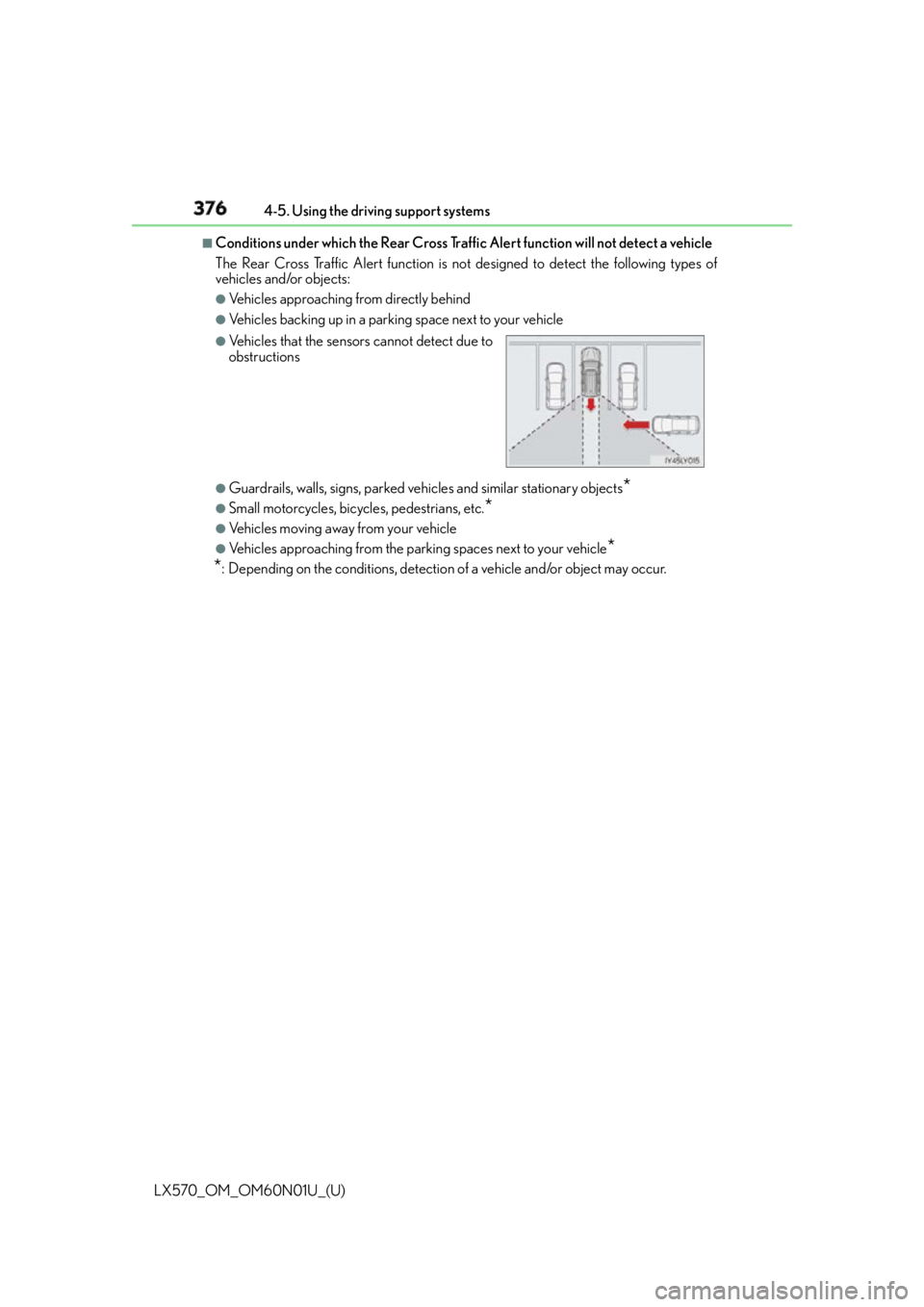
376
LX570_OM_OM60N01U_(U) 4-5. Using the driving support systems■
Conditions under which the Rear Cross Traffi c Alert function will not detect a vehicle
The Rear Cross Traffic Alert function is no t designed to detect the following types of
vehicles and/or objects: ●
Vehicles approaching from directly behind ●
Vehicles backing up in a parking space next to your vehicle
●
Guardrails, walls, signs, parked vehi cles and similar stationary objects
*●
Small motorcycles, bicycles, pedestrians, etc.
*●
Vehicles moving away from your vehicle ●
Vehicles approaching from the parking spaces next to your vehicle
*
* : Depending on the conditions, detection of a vehicle and/or object may occur. ●
Vehicles that the sensors cannot detect due to
obstructions
Page 377 of 632
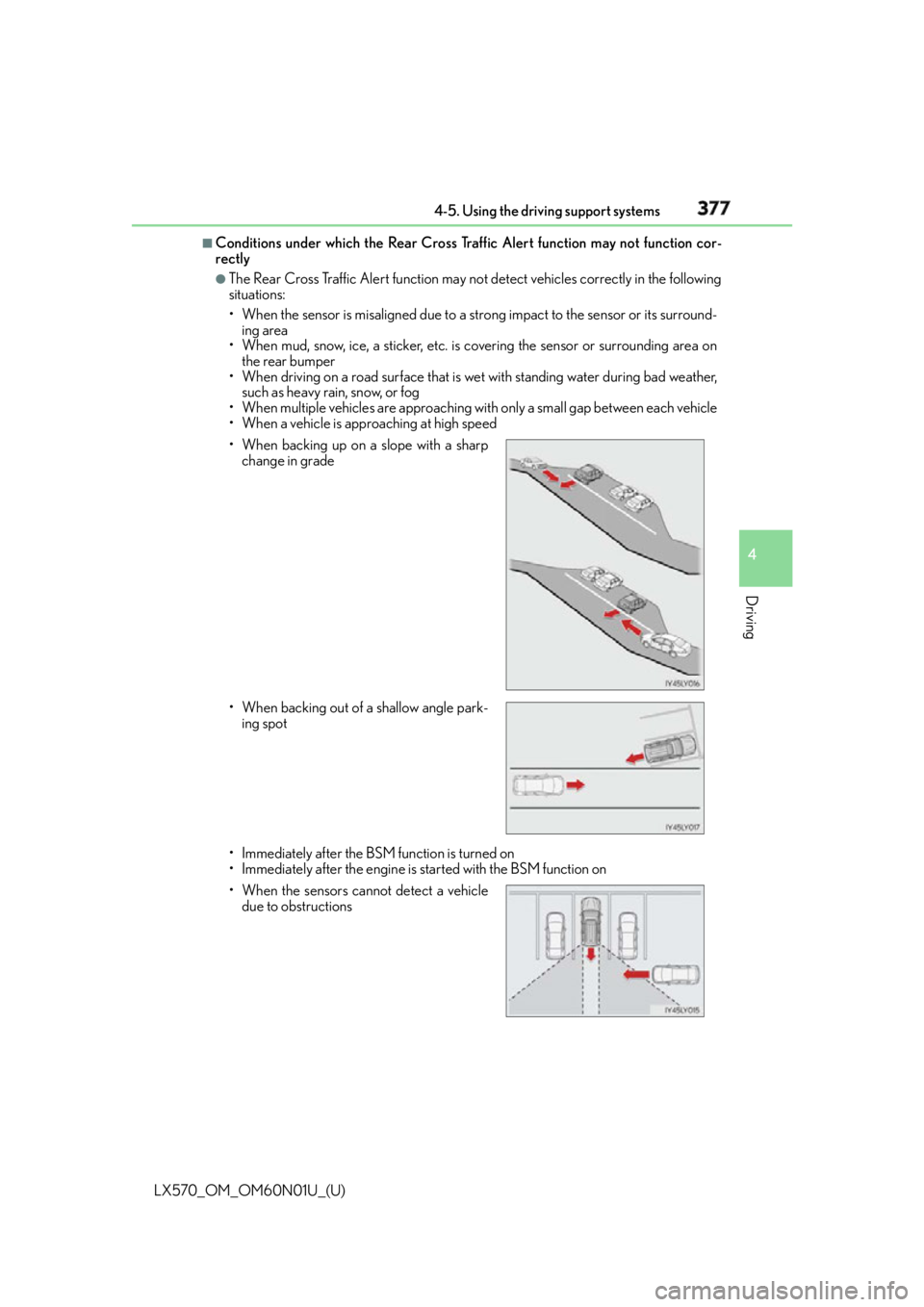
LX570_OM_OM60N01U_(U) 3774-5. Using the driving support systems
4
Driving ■
Conditions under which the Rear Cross Traf fic Alert function may not function cor-
rectly ●
The Rear Cross Traffic Alert function may not detect vehicles correctly in the following
situations:
• When the sensor is misaligned due to a strong impact to the sensor or its surround-
ing area
• When mud, snow, ice, a sticker, etc. is covering the sensor or surrounding area on
the rear bumper
• When driving on a road surface that is wet with standing water during bad weather,
such as heavy rain, snow, or fog
• When multiple vehicles are approaching wi th only a small gap between each vehicle
• When a vehicle is approaching at high speed
• Immediately after the BSM function is turned on
• Immediately after the engine is started with the BSM function on• When backing up on a slope with a sharp
change in grade
• When backing out of a shallow angle park-
ing spot
• When the sensors cannot detect a vehicle
due to obstructions
Page 378 of 632
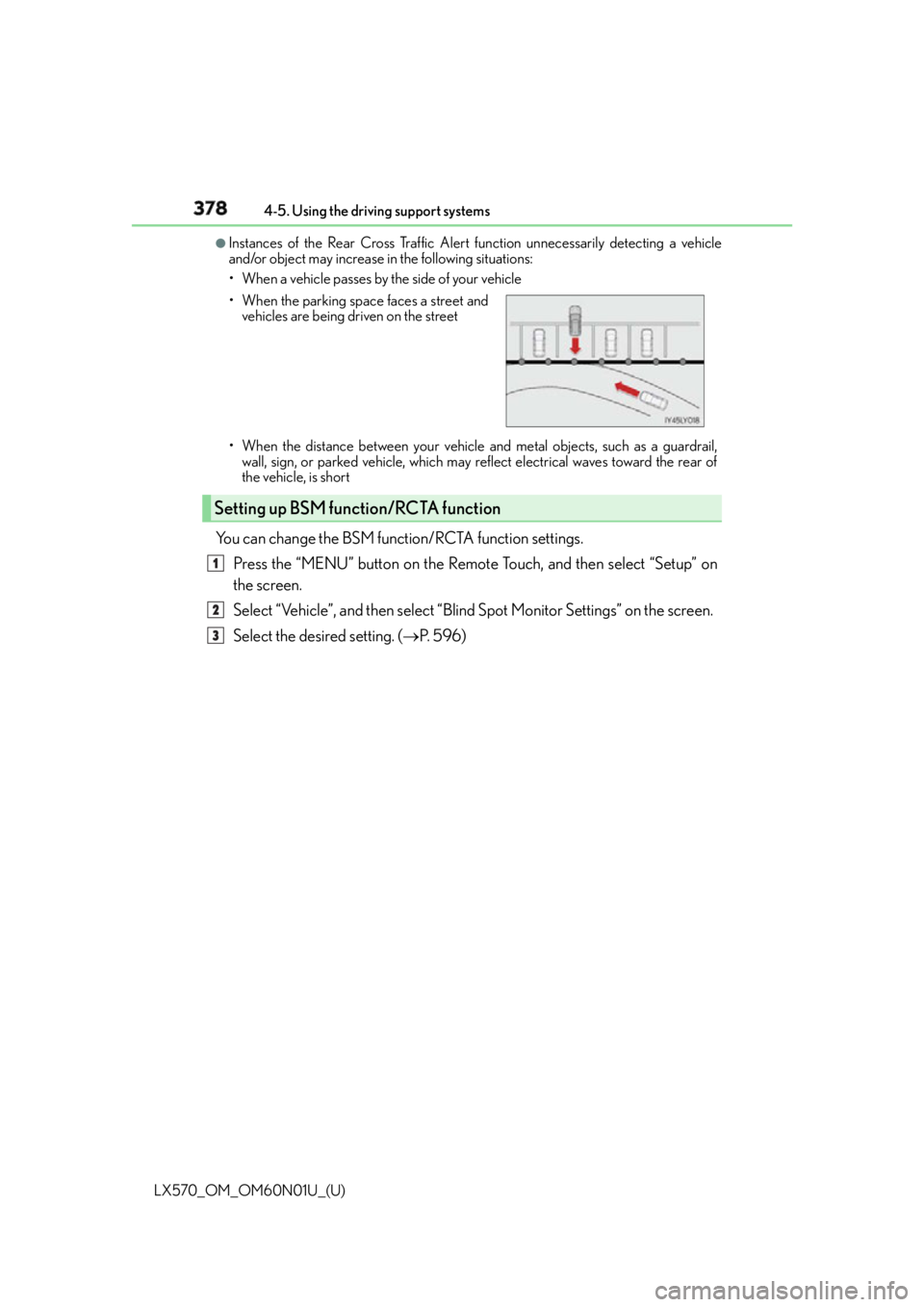
378
LX570_OM_OM60N01U_(U) 4-5. Using the driving support systems●
Instances of the Rear Cross Traffic Alert function unnecessarily detecting a vehicle
and/or object may increase in the following situations:
• When a vehicle passes by the side of your vehicle
• When the distance between your vehicle and metal objects, such as a guardrail,
wall, sign, or parked vehicle, which may reflect electrical waves toward the rear of
the vehicle, is short
You can change the BSM function/RCTA function settings.
Press the “MENU” button on the Remote Touch, and then select “Setup” on
the screen.
Select “Vehicle”, and then select “Blind Spot Monitor Settings” on the screen.
Select the desired setting. ( P. 5 9 6 )• When the parking spac e faces a street and
vehicles are being driven on the street
Setting up BSM function/RCTA function 1
2
3
Page 379 of 632

379
LX570_OM_OM60N01U_(U) 4-5. Using the driving support systems
4
Driving
Driving assist systems ◆ Multi Terrain ABS (Anti-lock Brake System) Helps to prevent wheel lock when the brakes are applied suddenly, or if the brakes are
applied while driving on a slippery road su rface, or in off-road conditions (such as
rough roads, sand and mud)
◆ Brake assist Generates an increased leve l of braking force after the brake pedal is depressed
when the system detects a panic stop situation
◆ VSC (Vehicle Stability Control) Helps the driver to control skidding when swerving suddenly or turning on slippery
road surfaces
◆ Active TRAC (Traction Control) Helps to maintain drive power and prevent the 4 wheels from spinning when starting
the vehicle or accelerating on slippery roads, or in off-road conditions
◆ Hill-start assist control Helps to reduce the backward movement of the vehicle when starting on an incline or
slippery slope
◆ AVS (Adaptive Variable Suspension system) By independently controlling the damping force of the shock absorbers for each of
the 4 wheels according to the road and dr iving conditions, this system helps riding
comfort with superior stee ring stability, and helps good vehicle posture. When
SPORT S+ mode is selected by the drivin g mode select switches, the damping force
is suitable for sporty driving. ( P. 2 8 6 )
◆ VGRS (Variable Gear Ratio Steering) Helps to adjust the wheel turning angle in accordance with the vehicle speed and
steering wheel movement.
◆ Trailer Sway Control Helps the driver to control trailer sway by selectively applying brake pressure for indi-
vidual wheels and reducing engine to rque when trailer sway is detected.
Trailer Sway Control is part of the VSC system and will not operate if VSC turned off
or experiences a malfunction.To help enhance driving safety and performance, the following systems oper-
ate automatically in response to various driving situations. Be aware, however,
that these systems are supplementary and should not be relied upon too
heavily when operating the vehicle.
Page 380 of 632
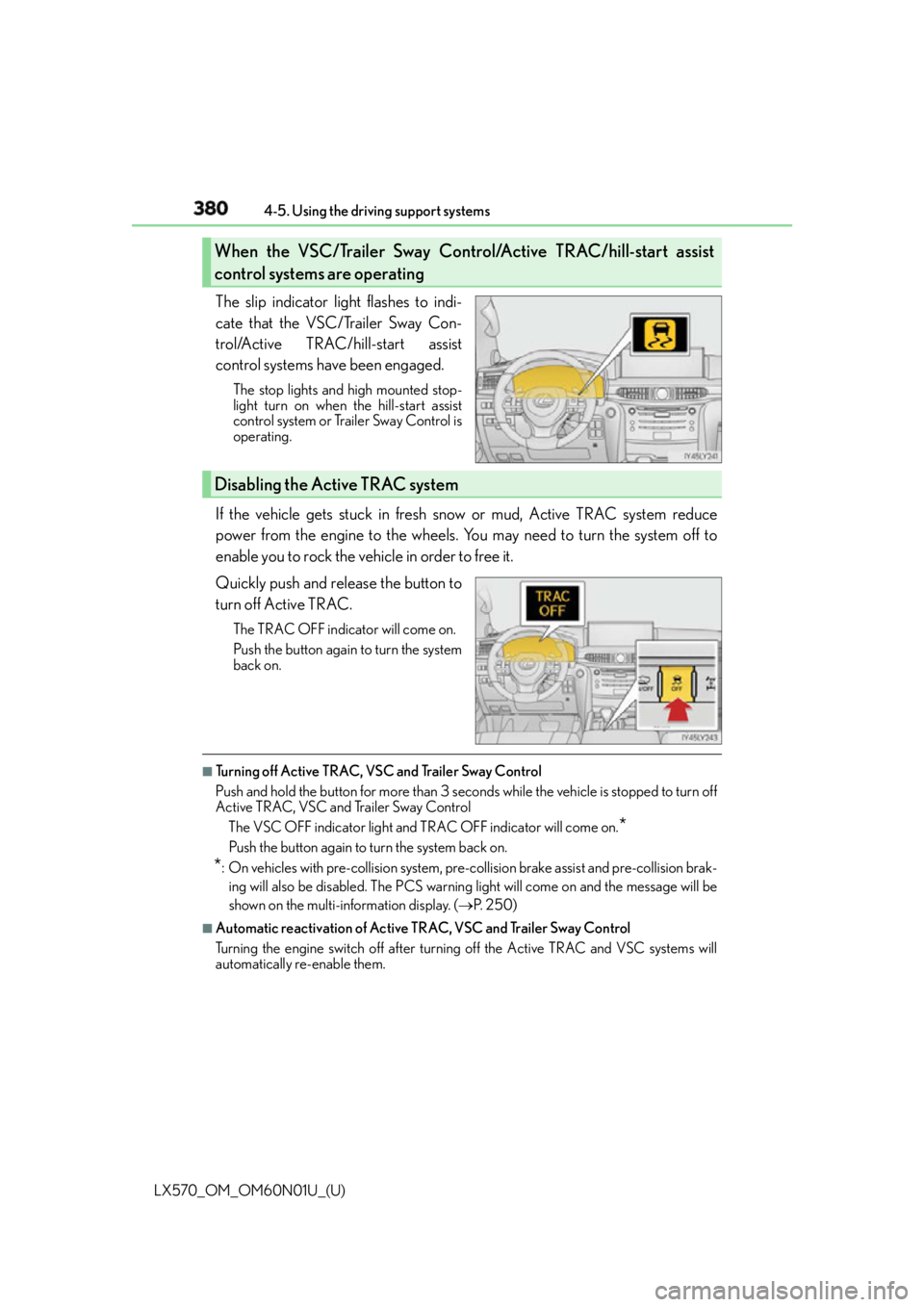
380
LX570_OM_OM60N01U_(U) 4-5. Using the driving support systems
The slip indicator light flashes to indi-
cate that the VSC/Trailer Sway Con-
trol/Active TRAC/hill-start assist
control systems have been engaged. The stop lights and high mounted stop-
light turn on when the hill-start assist
control system or Trailer Sway Control is
operating.
If the vehicle gets stuck in fresh snow or mud, Active TRAC system reduce
power from the engine to the wheels. You may need to turn the system off to
enable you to rock the vehicle in order to free it.
Quickly push and release the button to
turn off Active TRAC. The TRAC OFF indicator will come on.
Push the button again to turn the system
back on.
■
Turning off Active TRAC, VSC and Trailer Sway Control
Push and hold the button for more than 3 seconds while the vehicle is stopped to turn off
Active TRAC, VSC and Trailer Sway Control
The VSC OFF indicator light and TRAC OFF indicator will come on.
*Push the button again to turn the system back on.
* : On vehicles with pre-collision system, pre-collision brake assist and pre-collision brak-
ing will also be disabled. The PCS warning light will come on and the message will be
shown on the multi-information display. ( P. 2 5 0 )■
Automatic reactivation of Active TRAC, VSC and Trailer Sway Control
Turning the engine switch off after turning off the Active TRAC and VSC systems will
automatically re-enable them.When the VSC/Trailer Sway Control/Active TRAC/hill-start assist
control systems are operating
Disabling the Active TRAC system